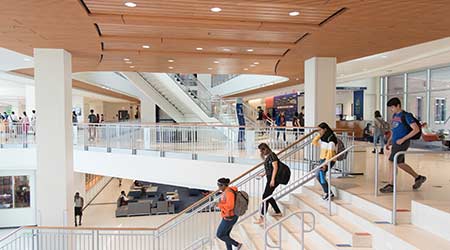 Strong leadership and clear communication were key elements in ensuring that upgrades at the University of Florida student union created minimal disruptions to the facility’s activities and operations.
Strong leadership and clear communication were key elements in ensuring that upgrades at the University of Florida student union created minimal disruptions to the facility’s activities and operations.HVAC and Lighting Upgrades Help University Cut Costs
Major lighting and HVAC upgrades help University of Florida’s student union meet user needs and cut energy costs
As a gathering place for students at the University of Florida, the J. Wayne Reitz Union has a great deal to offer. Built in 1967, the 648,173-square-foot facility features a range of spaces and operations — a bookstore, two ballrooms, 23 meeting rooms, two auditoriums, nine food service locations, a four-story atrium, a game room, two dance studios, and a parking garage.
But along with that vast array of offerings comes a multitude of issues related to inspecting and maintaining the building and its systems and, when necessary, upgrading and renovating systems and equipment in order to keep pace with evolving demands of an ambitious and active student population.
The management challenge that fell to Mike Mironack, the union’s director of operations, in 2009 was familiar to many managers — an aging facility, a growing mountain of deferred maintenance, and the need for a strategy that would enable the maintenance and engineering staff to bring the facility into the 21st Century.
Building a case
One of the first steps for Mironack, who has been with the university for 25 years, was to assess the facility’s condition, as well as systems and components that needed attention.
“We had a retrocommissioning study done in 2009, and they concluded we had about $47 million in deferred maintenance,” says Mironack, whose department — 32 full-time custodial staff and eight full-time maintenance staff — is an auxiliary operation at the university. “It was an extensive report broken down by discipline and what we needed to be doing and estimated costs. “We were able to address some of the low-hanging fruit, but they talked about the fact that we had 45-year-old air handlers. They were well-maintained; they ran. But they weren’t very efficient. Our HVAC plant was not terribly robust. We had an old infrastructure.”
Another step in the assessment process was determining the way students and staff interacted with the union and understanding their expectations of the facility.
“We also had architects perform a master plan study,” Mironack says. “They assessed what we were currently doing. They spoke with students and with other stakeholders to ask, ‘What does the union do well? What does it do poorly? What is needed?’ Showing that we had an aging structure and that we weren’t meeting the current needs of the university population, that gave us the data and stats that we needed to go forward and say, ‘We’re going to need to do something about this.’ “
“Through a lot of effort, we were able to get student support, and when the students showed their support, the administration started supporting it.”
Gaining student support was essential because it built the foundation for financial support. “We are part of the division of student affairs within the University of Florida, but our operation receives no tax dollars, tuition dollars, or any other university support,” Mironack says. “As for our operating funds, students pay an activity and service fee as part of their registration costs. Those are specific fees not related to academics. They pay the fee, and our student government allocates that activity and service fee, and that covers about 60 percent of our operating costs.”
One key piece of funding for the upgrades came from an energy service contract (ESCO).
“The university was exploring ESCO contracts, so it was put out there that this would be a way for us to address some of the infrastructure,” he says, adding that the ESCO partner “came in and studied everything and gave us energy-conservation measures. They were able to guarantee energy savings, and we used those savings to pay off the financing that we used for the major upgrades.”
Related Topics:














